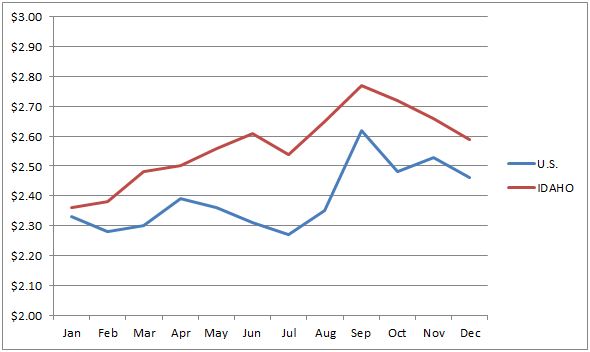Idahoans paid 28 cents more per gallon than in 2016
BOISE – (January 9, 2018) – In a year marked by high travel demand, Idahoans experienced a reversal of fortune in 2017 pump prices, paying an average of 28 cents more per gallon than they did in 2016. In 2017, Gem State drivers also paid 18 cents more than the national average.
“In 2016, Idaho gas prices reached their lowest point in a dozen years, dropping to an average of just $2.29 per gallon,” says AAA Idaho spokesman Matthew Conde. “But last year, strong travel activity and other factors created some headwinds that held the average price at $2.57.”
Across the country, millions of additional travelers hit the road for major holiday getaways last year, along with the rare opportunity to view a total solar eclipse in several states, including Idaho.
Meanwhile, supply issues also came into play. OPEC’s crude oil production cuts continued throughout the year. Hurricanes Harvey, Irma, and Maria created major distribution challenges and caused a number of refinery shutdowns in the Gulf Coast. U.S. suppliers also exported up to 1 million barrels of crude oil per day, much of it to Central and South America – a record high and an increase of 445,000 b/d from the 2016 average. The growth of the export market may have applied some upward pressure on U.S. fuel prices.

Figure 1 – Comparison of 2017 U.S. and Idaho average gas prices. By the end of the year, Idaho was just seven cents above the national average.
“On the heels of eclipse travel, the three major hurricanes shocked the oil and petroleum markets, and gas prices jumped dramatically to end the summer,” Conde said. “While holiday travel remained high, fuel prices finally relaxed to end the year, dropping by 20 cents on the national average and by 24 cents here in Idaho.”
Today, the U.S. average pump price is $2.49, which is two cents more than a month ago and thirteen cents more than a year ago. In Idaho, drivers are paying $2.55 a gallon, which is seven cents less than a month ago, but 19 cents more than a year ago. AAA expects fuel demand to continue to drop over the next couple of months, which should lead to a decrease in gas prices before the return to warmer weather and the switch to more-expensive summer-blend fuel.
“Idaho prices dropped nine cents over the past month, joining neighbors Colorado, Utah and Wyoming in some much-needed savings,” Conde said. “Hopefully it’s a signal that more relief is on the way this winter.” This week, the regional gas inventory is back above the 7-million-barrel mark.

2018 gas price predictions
Barring any unforeseen circumstances, AAA projects that 2018 Idaho average gas prices will fall somewhere in the range of $2.65 to $2.85 per gallon.
Here are some of the key considerations in AAA’s prediction:
- Crude oil market activity – OPEC recently announced plans to extend production cuts through the end of 2018 in an attempt to re-balance the global market. Meanwhile, U.S. production continued to expand last year. The current number of active oil rigs is 742, hundreds above last year’s count. Domestic oil production could counteract some of OPEC’s efforts to drive global crude prices higher. At the same time, U.S. oil exporters are on track to continue their record pace. A strong secondary market could keep gas prices higher here. AAA and other interested parties will watch closely to determine the effect of these market forces on U.S. and Idaho gas prices.
- Regional supply not in step with population growth – “There hasn’t been any real growth in the Rockies fuel supply chain for more than a decade,” Conde said. “On the other hand, Idaho is one of the fastest-growing states in the country, so continued population growth and high travel demand can definitely impact regional gas prices.”
- A robust economy – 2017 was another year of high consumer confidence and relatively low unemployment, inspiring more travelers to cross a journey off their bucket lists. The trend could create opportunism for refiners, wholesalers and retailers to command higher prices.
AAA will continue to monitor changing market conditions that could impact price movement.
A barrel of crude is currently trading near $62 on the West Texas Intermediate benchmark. That’s nearly five dollars more than a month ago and about ten dollars more than a year ago.
Here’s a sample of current gas prices across the state: Ammon – $2.46; Blackfoot – $2.49; Boise – $2.56; Burley – $2.53; Cascade – $2.76; Coeur d’Alene – $2.55; Dalton Gardens – $2.52; Downey – $2.55; Emmett – $2.54; Franklin – $2.48; Fruitland – $2.545; Glenns Ferry – $2.49; Hailey – $2.69; Horseshoe Bend – $2.70; Idaho Falls – $2.44; Ketchum – $2.86; Kuna – $2.53; Lewiston – $2.68; McCall – $2.81; Mountain Home – $2.52; Oakley – $2.54; Parma – $2.60; Payette – $2.54; Pocatello – $2.44; Post Falls – $2.59; Rexburg – $2.48; Sandpoint – $2.64; Twin Falls – $2.52; Weiser – $2.51.
“Gas prices should stay well below $3 this year, and as long as they do, 2018 should provide plenty of opportunity for another great road trip,” Conde said.
U.S. average gas prices: 2013 – $3.49; 2014 – $3.34; 2015 – $2.40; 2016 – $2.12; 2017 – $2.39
Idaho average gas prices: 2013 – $3.51; 2014 – $3.40; 2015 – $2.51; 2016 – $2.29; 2017 – $2.57

